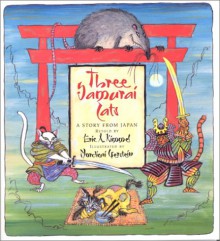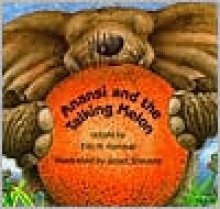

Genre: Japan / Animals / Trickery / Folktale / Peace
Year Published: 2003
Year Read: 2008
Publisher: Holiday House
Source: Library

“Three Samurai Cats” is an ancient Japanese folktale about how three samurai cats come to the Daimyo’s castle to defeat a savage rat with the last samurai cat giving the rat a taste of his own medicine. Eric A. Kimmel’s hilarious retelling and Mordicai Gerstein’s colorful drawings combine greatly to make a great and funny story from ancient Japan.
Eric A. Kimmel’s humorous storytelling of an ancient Japanese folktale is extremely inventive and witty as the last samurai cat uses a nonviolent stragety to defeat the rat at the end of the book. I found the part where the rat kicks the fierce samurai cat across the room to be extremely funny since the samurai cat looked funny when he crashed to the ground. Mordicai Gerstein’s illustrations are colorful yet scratchy, giving the story a humourous edge. One of the illustrations that really stood out the most for me was the image of Neko Roshi giving an intense look after he had just woken up when the rat yelled out “help!” when he was stuck in the rice ball. Neko Roshi’s eyes look huge like when a cat sees something that terrifies it and his hair also stood on its end. 
“Three Samurai Cats” is an excellent story about how violence does not always solve the problem and how clear thinking can always win the battle if you allow the right moment to come. I would recommend this book to children ages five and up since the younger children might not understand the Japanese vocabulary, such as daimyo and docho.
Review is also on: Rabbit Ears Book Blog


Hanukkah Bear is an adorable story about old Bubba Brayna, who accidentally hosts a night of Hanukkah for a bear. It is incredibly silly and gives a taste of what Hanukkah is like.
This book received a AD370L on the Lexile scale, and would be most appropriate for fourth graders and up. This book would be a great way to introduce a class discussion about celebrations from other cultures. The recipe at the end is a nice touch, and would be fun to share with a class. The book itself is silly and fun and would make a great addition to a class library..

Genre: Animals / Folktale / Africa / Trickery
Year Published: 1994
Year Read: 2016
Publisher: Holiday House
Series: Anansi #2

Now, I have been reading the “Anansi” series ever since I was little and I was always so amazed at the gorgeous artwork and the hilarious writing in each book! So, when I stumbled upon another “Anansi” story that was written by Eric A. Kimmel along with illustrations by Janet Stevens, I was pleasantly surprised by how this story turned out to be as entertaining as the previous “Anansi” stories!
The story starts off with Anansi looking down on Elephant’s melon patch from the trees and he wanted to have a melon. But since Anansi was always too lazy to do any work, he decided to wait until Elephant went off on break to eat a melon. So after Elephant left the melon patch, Anansi took a thorn from a tree and started digging a hole inside the melon to jump inside and eat the melon from the inside out. Once Anansi was done eating inside the melon, he tried to get out from inside the melon, but he become too fat to get out and he had to wait until he got thin again. Elephant then comes back to the melon patch and picks up the melon that Anansi was inside of and Anansi decided to play a little trick on Elephant by pretending to be the melon and successfully convinces Elephant that the melon is really talking. Elephant is so excited about this development that he decided to tell his friends and the king about the talking melon.
Will the King be impressed by the talking melon or will he realize that it is Anansi playing this trick?
Read this book to find out!
Wow! I must admit that I was quite surprised that I have not read this book yet since I have been reading the “Anansi” series ever since I was a child! Eric A. Kimmel has once again done an excellent job at writing this story as the story is highly creative and hilarious at the same time and I really loved the scenes where Anansi tricks the other animals into thinking that the melon is actually talking to them. I like the fact that in this story, Anansi does not actually steal anything like he did in the previous book “Anansi and the Moss-Covered Rock” since it makes him into a less amoral character (although he still did dig inside one of the Elephant’s melons without Elephant’s permission) and the fact that he is just playing tricks on Elephant and the other animals just for the fun of it, makes him less malicious in nature. Janet Stevens’ artwork is as usual gorgeous to look at and I loved the way that Janet Stevens is able to convey the emotions on the characters’ faces, especially whenever the melon seems to insult each animal character and you get to see the animals’ angry expressions really close up.
Overall, “Anansi and the Talking Melon” is a truly hilarious book that is another great addition to Eric A. Kimmel and Janet Stevens’ “Anansi” series! I would recommend this book to children ages four and up since there is nothing inappropriate in this book.
Review is also on: Rabbit Ears Book Blog

Genre: Animals / Folktale / Africa / Trickery
Year Published: 1988
Year Read: 1997
Publisher: Holiday House
Series: Anansi #1

“Anansi and the Moss-Covered Rock” is an old African folktale retold by Eric A. Kimmel, along with illustrations by Janet Stevens. This book is about how Anansi the Spider tries to trick all the animals in the forest by showing them a mysterious rock. This book is surely a delight to anyone who is interested in African folktales.
The story starts off with Anansi the Spider walking through the forest when he spotted a strange looking moss-covered rock and then he exclaims:
“Isn’t this a strange moss-covered rock?”
Suddenly, Anansi falls down unconscious and when he wakes up again, he is confused at what had just happened and when he repeated:
“Isn’t this a strange moss-covered rock?”
He falls back down again and when he wakes up the second time, he realizes the power of the moss-covered rock and he decides to use it to his advantage. Anansi then goes around tricking the other animals such as Lion and Elephant, by leading them to the moss covered rock and once the animals repeat the magic words:
“Isn’t this a strange moss-covered rock?”
They fall down unconscious on the ground and Anansi goes back to their houses and steals their food. Meanwhile, Little Bush deer has been watching Anansi the whole time and she decided to teach Anansi a lesson when Anansi tries to trick her into going to see the moss-covered rock.
Will Little Bush Deer fall for Anansi’s trick or will Little Bush Deer have the last laugh?
Read the rest of this book to find out!
Eric A. Kimmel’s retelling of this ancient folktale is hilarious and charming as Anansi uses a magical rock to get what he wants or at least that what he thinks. I thought that the idea of using an unlikely substance such as the moss-covered rock to take advantage of people by knocking them unconscious was ingenious since we usually hear about how people would simply use magic spells to control people. Janet Stevens’ illustrations are done beautifully as she illustrates each animal with realistic features that they make the animals seem to come alive in this book. The illustrations are also extremely colorful especially of the images of the forest itself as the plants are mainly in colors of pink, green, brown, and all manner of other colors and they make this book extremely bright to look at. Probably, the image that stood out the most was the image of Anansi himself as he has small beady eyes and long legs.
“Anansi and the Moss-Covered Rock” is a superb tale about how tricking someone can get you in massive trouble if you are not careful and many children would definitely call this an instant treat to read over and over again. I would recommend this book to children ages five and up since I do not find anything wrong with this book, unless children might have a hard time pronouncing Anansi’s name.
Review is also on: Rabbit Ears Book Blog